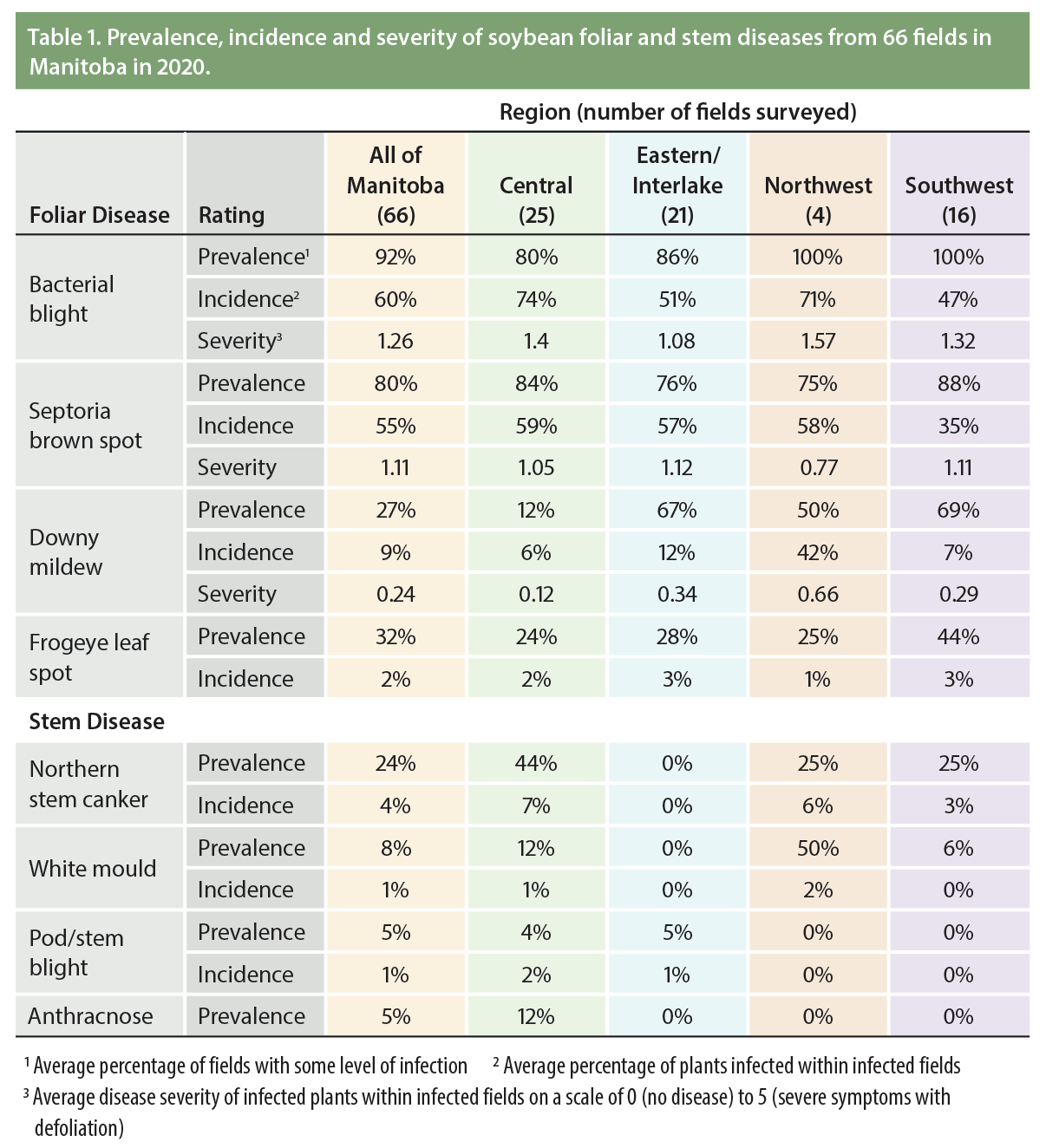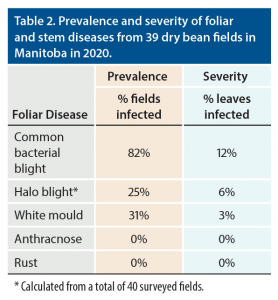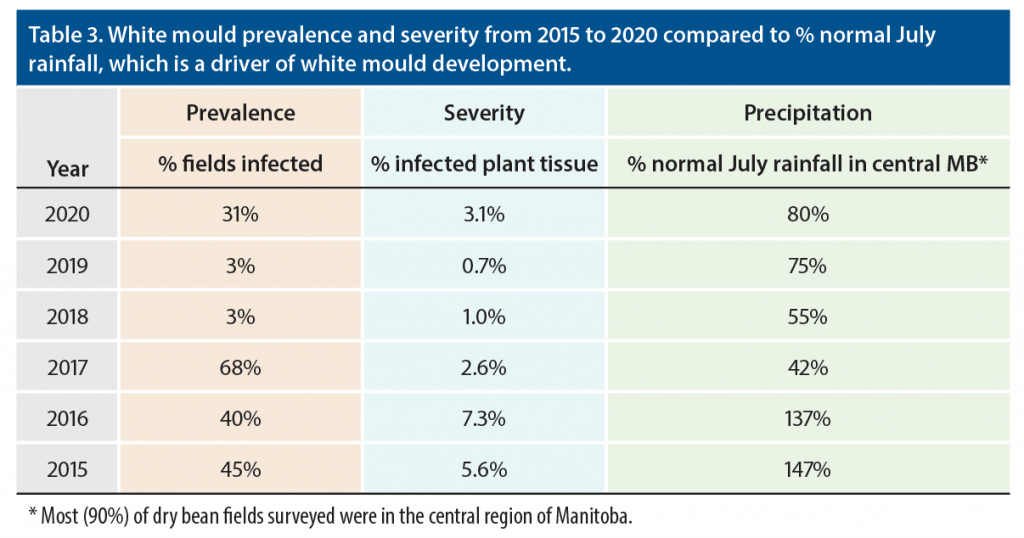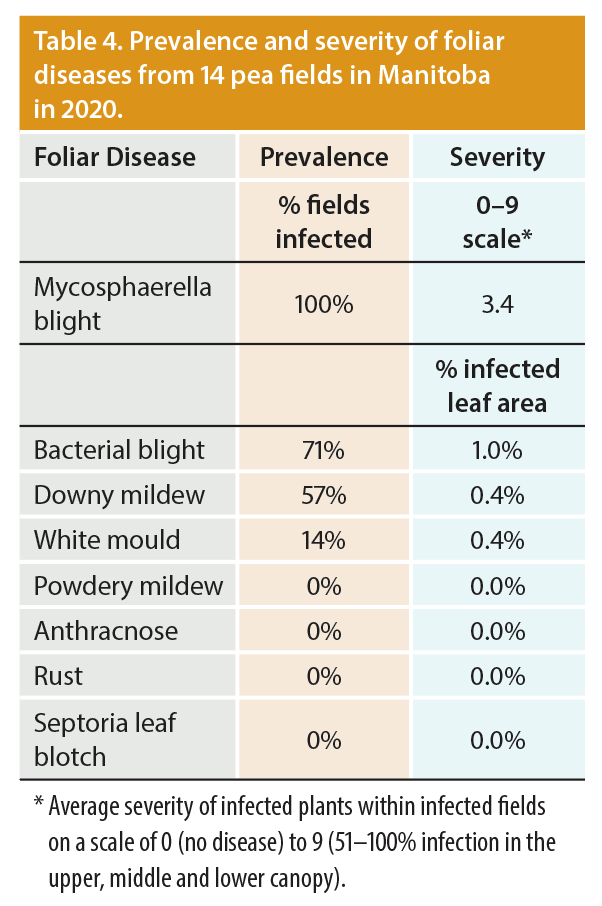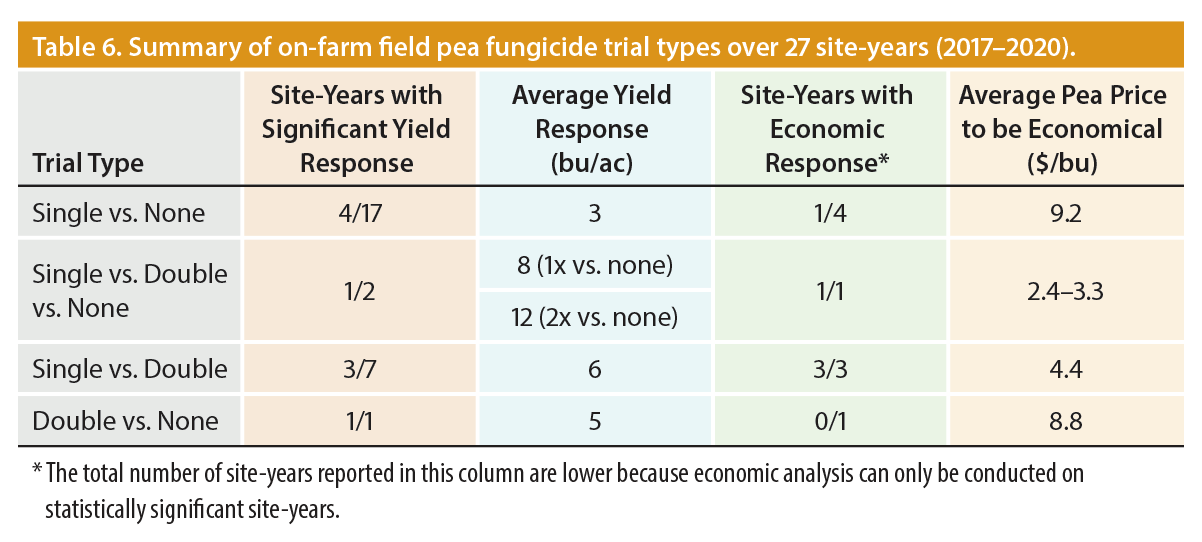Cassandra Tkachuk, Production Specialist – East and Laura Schmidt, Production Specialist – West – Summer (June) 2021 Pulse Beat
Each year, a representative sample of soybean, field pea and dry bean fields are surveyed for root, foliar and stem diseases across Manitoba. These surveys are a collaborative effort between Agriculture and Agri-Food Canada, Manitoba Agriculture and Resource Development and Manitoba Pulse & Soybean Growers. Here are the results from the 2020 foliar and stem disease surveys. Root rot results can be found in the spring 2021 issue of Pulse Beat.
The On-Farm Network has also been testing the use of foliar fungicides in soybeans, dry beans and field peas over the past several years to evaluate the performance of these products under a range of environments. Find the on-farm results after each survey summary in this article.
SOYBEAN DISEASE SURVEY
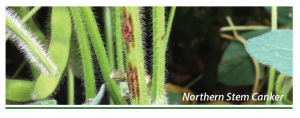 A total of 66 fields were surveyed for soybean foliar and stem diseases at the R6 (full seed) stage in 2020. Soybeans were visually assessed for infection by bacterial blight, Septoria brown spot, downy mildew, frogeye leaf spot, northern stem canker, white mould, pod/stem blight and anthracnose.
A total of 66 fields were surveyed for soybean foliar and stem diseases at the R6 (full seed) stage in 2020. Soybeans were visually assessed for infection by bacterial blight, Septoria brown spot, downy mildew, frogeye leaf spot, northern stem canker, white mould, pod/stem blight and anthracnose.
Bacterial blight and Septoria brown spot were again the most common foliar diseases of soybeans in Manitoba (Table 1). These diseases were easily identified in fields, but mainly present at low severity levels, meaning their impact on yield was low overall. A severity level of one means only trace symptoms of that disease were found.
We are generally more concerned about soybean stem and root diseases than foliar diseases. Stem disease levels were low in 2020, having little to no impact on yield. Northern stem canker is relatively new and has somewhat risen the ranks, partially due to a longer soybean-growing history in Manitoba and more confident diagnosis by surveyors. We plan to continue monitoring the lower crop canopy for this and other stem diseases in future surveys.
ON-FARM EVALUATION OF FOLIAR FUNGICIDE IN SOYBEANS
Since 2014, 66 replicated and randomized field-scale trials have been conducted through the On-Farm Network to evaluate foliar fungicide in soybeans. The main goal for fungicide application in soybeans is to control white mould. However, white mould (Sclerotinia) is not the yield robber in soybeans that can be in other crops.
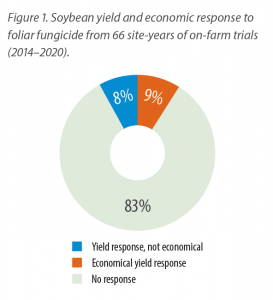 Of the 66 site-years, 11 (17%) have had significant yield responses. Only six of those significant site-years (9%) resulted in a positive return on investment, where the yield increase was great enough to cover the cost of fungicide application (Figure 1).
Of the 66 site-years, 11 (17%) have had significant yield responses. Only six of those significant site-years (9%) resulted in a positive return on investment, where the yield increase was great enough to cover the cost of fungicide application (Figure 1).
An economic response of 9% boils down to a profit from fungicide in one out of 11 years. If you were to utilize fungicide each year for 11 years, that would amount to an approximate accumulated cost of $165/ac. Your single-year profit boost might be $1/ac to $20/ ac, but it is not enough to cover the accumulated cost from years where it did not pay for itself.
How do you predict the year where you will see a profit boost? Determine the likelihood of disease development each season and in each field, since profitability depends on white mould presence. Disease is likely to develop if conditions are wet and cool (< 21°C) leading up to flowering, if your field has a history of white mould and if there are signs of disease development while scouting (e.g., apothecia on the soil surface ahead of flowering).
DRY BEAN DISEASE SURVEY
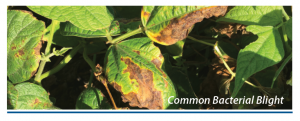 In 2020, 39 dry bean fields were surveyed for foliar and stem diseases during mid-August when plants were starting to mature. Most fields were in southern Manitoba and 10% of surveyed fields were outside of the traditional bean-growing regions. Fields were visually assessed for common bacterial blight, halo blight, white mould, anthracnose and rust.
In 2020, 39 dry bean fields were surveyed for foliar and stem diseases during mid-August when plants were starting to mature. Most fields were in southern Manitoba and 10% of surveyed fields were outside of the traditional bean-growing regions. Fields were visually assessed for common bacterial blight, halo blight, white mould, anthracnose and rust.
Common bacterial blight was the most prevalent foliar disease in Manitoba (Table 2). It infects plants following any kind of tissue abrasion or damage from strong storms. Foliar products are available, but their effectiveness has been variable so far and they often require multiple applications throughout the season.
ON-FARM EVALUATION OF FOLIAR FUNGICIDE IN DRY BEANS
Since 2016, 14 replicated and randomized trials have been conducted to evaluate foliar fungicide application in dry beans through the On-Farm Network. White mould and anthracnose are the disease targets of foliar fungicide in dry beans, but white mould is the main concern. Anthracnose was not found during the 2020 survey and has not been a recent issue for dry beans due to variety resistance.
Over the duration of these on-farm trials, we have not seen any statistically significant yield responses to foliar fungicide in dry beans. Why? Trial sites were dry and did not have any white mould pressure. If the disease pressure is not there, fungicide will not provide much of a service. It should also be noted that dry beans in these trials were grown on wide rows (30 inches). These trials will continue in 2021 to capture more locations and environments.
Fungicide application timing for dry beans is in July at the start of flowering to protect plants from the potential spread of sclerotinia ascospores through flower petal drop. Intuitively, the amount of dry bean crops infected by white mould follows the trend of July precipitation year to year (Table 3). High rainfall in 2015 and 2016 led to greater disease levels, and it is likely that sclerotia bodies produced from those crops led to higher disease loads in 2017. Looking at the dry years that followed, disease levels were brought down.
For 2021, use rainfall amounts leading up to and during dry bean flowering to anticipate the development of white mould in your fields. Consider field history of host crops and disease pressure. If white mould levels were high in previous crops, the carryover of sclerotia bodies in the soil will increase your risk of disease development. Also scout for signs of disease development ahead of fungicide application and use the Fungicide Decision Worksheet for Managing White Mould in Dry Beans.
FIELD PEA DISEASE SURVEY
In 2020, 14 pea fields were surveyed for Mycosphaerella blight, bacterial blight, downy mildew, white mould, powdery mildew, anthracnose, rust and Septoria leaf blotch. The number of fields was lower compared to past years due to COVID-19 constraints. Surveying took place during mid- to late-July at the R3 to R4 (flat to full pod) stages.
Find a detailed summary of 2020 results in Table 4 and a summary of Mycosphaerella blight, bacterial blight and white mould results from 2015 to 2020 in Table 5. Mycosphaerella blight has been found in every surveyed pea field since 2015 (Table 5). Over the past five years, the greatest severity of Mycosphaerella blight occurred in 2016 due to wet conditions and a high frequency of summer storms. A score of 6.0 indicates that, on average, plants had symptoms on < 20% of the upper canopy, 21–50% of the mid canopy and on 51–100% of the lower canopy. Not reported in Table 5 are powdery mildew, anthracnose and Septoria leaf blotch, which have not been detected in Manitoba in the past five years.
In 2020, bacterial blight was easily identified in 71% of surveyed fields. High infection levels were due to early-season storms and strong winds that wounded plants, creating openings for bacterial blight to infect peas. Thankfully, only 1% of leaf tissue was infected, on average.
ON-FARM EVALUATION OF FOLIAR FUNGICIDE IN FIELD PEAS
Since 2017, 27 randomized and replicated, field-scale trials have been conducted across Manitoba to evaluate foliar fungicide in peas. Of the 27 trials, 17 have compared single vs. no fungicide, two have compared double vs. single vs. none, seven have compared double vs. single and one has compared double vs none (Table 6). Mycosphaerella blight and white mould are the targets of foliar fungicide in peas. However, Mycosphaerella is the main concern in most years.
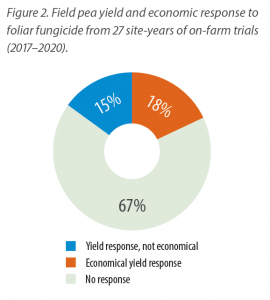 These on-farm trials have shown us that field peas are more responsive to foliar fungicide than soybeans or dry beans. According to the aggregated results, yield increases occurred 33% of the time, but profit increases only occurred 18% of the time (Figure 2). Overall, the economic responsiveness of peas has been relatively low in these last few drier years.
These on-farm trials have shown us that field peas are more responsive to foliar fungicide than soybeans or dry beans. According to the aggregated results, yield increases occurred 33% of the time, but profit increases only occurred 18% of the time (Figure 2). Overall, the economic responsiveness of peas has been relatively low in these last few drier years.
When we examine the different trial types in Table 6, there have been more frequent, larger and more reliable economic responses from double fungicide application. However, this does not mean that double application is always the best practice. It simply means that double application may be necessary at times to control substantial disease pressure.
Pea yield response to fungicide varies among farms and will only be economical if the disease pressure is there, or if conditions are conducive to its development. Use the new Fungicide Decision Worksheet for Managing Mycosphaerella Blight in Field Peas to help you decide if fungicide will be beneficial in your field.

